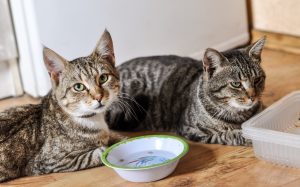Feline Leukemia (FeLV): Symptoms, Signs & Treatment

What is the Feline Leukemia Virus?
Feline Leukemia Virus (FeLV) is a retrovirus that affects cats worldwide. It is a leading cause of illness and death in felines. FeLV attacks the immune system, making cats vulnerable to infections, tumors, and other diseases. The virus is primarily transmitted through close contact with infected cats, such as sharing food and water bowls, grooming, or mating.
Is Feline Leukemia Virus Contagious?
Yes, FeLV is highly contagious among cats. It can be transmitted through saliva, nasal secretions, urine, and feces. Kittens can contract the virus from their mother during birth or through nursing. Adult cats can also become infected through bites from infected cats. It’s important to note that FeLV does not pose a risk to humans or other non-feline pets.
How to Prevent Transmission of FeLV?
Preventing the transmission of FeLV is crucial to protect your cat. Here are some ways to minimize the risk:
Vaccination
Vaccination is an essential step in preventing FeLV. Kittens should receive their initial FeLV vaccination series starting around eight weeks of age. Adult cats with unknown vaccination status should also be vaccinated. It’s important to consult with your veterinarian to determine the best vaccination schedule for your cat.
Keeping Cats Indoors
Limiting your cat’s exposure to potentially infected cats can significantly reduce the risk of FeLV transmission. Keeping your cat indoors protects them from encounters with stray or unknown cats. If your cat enjoys outdoor time, consider creating a secure and enclosed space to minimize contact with other felines.
Testing and Regular Checkups
Regular veterinary visits are crucial for monitoring your cat’s health and detecting FeLV early. Your veterinarian can conduct a simple blood test to determine if your cat has been exposed to the virus. Early detection allows for prompt intervention and increases the chances of successful treatment.
Providing a Balanced Diet
A well-balanced diet plays a vital role in maintaining a cat’s overall health and immune system. Ensure your cat’s diet consists of high-quality, nutritious food that meets their specific nutritional needs. Consult with your veterinarian to determine the best diet plan for your feline companion.
FeLV Stages
Feline Leukemia Virus progresses through three stages: primary viremia, secondary viremia, and persistent infection.
Primary Viremia
During this stage, the virus replicates in the tonsils and lymph nodes, temporarily residing in the bloodstream. Cats in this stage may show no symptoms or experience mild, flu-like symptoms that resolve on their own.
Secondary Viremia
In the secondary viremia stage, the virus spreads throughout the cat’s body, affecting the bone marrow, spleen, and other organs. Cats may begin to show more severe symptoms, including weight loss, anemia, and recurring infections.
Persistent Infection
At this stage, the virus becomes a permanent resident of the cat’s body. Cats may remain asymptomatic carriers or develop various health complications, such as cancer, immune disorders, or reproductive issues. The duration and severity of the persistent infection can vary from cat to cat.
What Are the Signs and Symptoms of FeLV?
Recognizing the signs and symptoms of FeLV is crucial for early detection and intervention. It’s important to note that some cats may remain asymptomatic for extended periods, while others may exhibit various symptoms, including:
- Loss of appetite and weight loss
- Lethargy and weakness
- Pale gums and mucous membranes
- Swollen lymph nodes
- Diarrhea or abnormal bowel movements
- Persistent fever
- Respiratory problems
- Poor coat condition
- Increased susceptibility to infections
- Neurological abnormalities
Keep in mind that these symptoms can also be indicative of other health conditions. If you notice any changes in your cat’s behavior or health, consult with your veterinarian for a thorough examination and appropriate testing.
How is FeLV Diagnosed?
FeLV diagnosis involves a combination of blood tests and physical examinations. Your veterinarian will conduct a thorough examination of your cat, looking for signs of FeLV-related complications. They will also perform a blood test to detect the presence of FeLV antigens or antibodies.
The most common blood test used to diagnose FeLV is the ELISA (Enzyme-Linked Immunosorbent Assay) test. This test detects the virus in the bloodstream. In some cases, additional tests may be necessary, such as PCR (Polymerase Chain Reaction) or immunofluorescent antibody tests, to confirm the diagnosis or determine the stage of infection.
Treatment Options for FeLV
While there is no cure for FeLV, various treatment options aim to manage symptoms, improve the cat’s quality of life, and prolong survival. The treatment plan will depend on the cat’s overall health, the stage of FeLV, and the specific complications present.
Supportive Care
Providing supportive care is essential to helping cats with FeLV cope with their symptoms and maintain a good quality of life. This includes ensuring proper nutrition and hydration and keeping the cat’s environment stress-free.
Antiviral Medications
Antiviral medications, such as interferon or protease inhibitors, may be prescribed to inhibit the replication of FeLV. These medications can help slow down the progression of the virus and reduce the severity of symptoms.
Managing Secondary Infections
FeLV weakens the immune system, making cats susceptible to secondary infections. Your veterinarian may prescribe antibiotics or other medications to combat bacterial, viral, or fungal infections.
How Can Pet Insurance Help You if Your Cat Has Leukemia?
Pet insurance can be a valuable tool in managing the costs of treating feline leukemia and other veterinary expenses. By having a pet insurance policy in place, you can have peace of mind knowing that you can provide medical care for your furry companion without worrying about the financial burden. Pet insurance can help cover the costs of veterinary consultations, diagnostic tests, medications, and even specialized treatments if required.
Reimbursement
This method is the most common for pet insurance companies. You pay out of pocket for the veterinarian bill, and then the insurance company reimburses you for what’s covered under the insurance plan. The steps look like this.
- You pay the vet bill after your cat’s visit.
- You fill out the pet insurance claim form.
- Submit the claim form and other required documentation to the insurer.
- After the claim is approved, you will be reimbursed for eligible expenses.
What Does Odie Pet Insurance Cover?
Pet insurance covers various veterinary expenses, providing financial protection and peace of mind for pet owners. Here are the details of the coverage options offered by Odie Pet Insurance:
Illness & Injury Plan
The Illness & Injury Plan is an all-inclusive insurance plan designed to cover a wide range of medical needs for your pet. This plan includes comprehensive coverage for various illnesses, injuries, and veterinary services. Some of the covered items include:
- 24/7 Televet Chat
- Emergency vet visits
- Overnight hospital stays
- IV Fluids & Medications
- Medical Supplies
- Surgeries
- MRI/CAT Scans
- Rehabilitative Care
- Prescription Medications
- Gastrointestinal issues
- Laboratory Tests
Accident-Only Plan
The Accident-Only Plan is designed for pet owners seeking coverage specifically for accidents. This plan provides financial protection for emergency veterinary care resulting from accidental injuries. It includes 90% reimbursement up to $10,000 each year, with a $250 annual deductible.
Here’s an overview of the Accident-Only Plan:
- Coverage for broken bones, sprains, eye injuries, and traumatic dental fractures.
- Coverage for wounds, including bite wounds, lacerations, snake bites, and bee stings.
- Veterinary treatments covered for accidental injuries include X-rays & ultrasounds, laboratory tests, emergency care, hospitalization, CT scan & MRI, and surgery.
The Wellness Add-on Plan
The Wellness Plan is an add-on for routine care coverage you can purchase with an insurance policy. It focuses on preventive care and covers routine veterinary services. Odie has two wellness plan options available:
Basic Plan:
- Covers services such as spay/neuter and teeth cleaning, rabies vaccination, flea & tick prevention, heartworm prevention, vaccination/titer, wellness exam, heartworm test or FELV screen, blood, fecal, parasite exam, microchip, urinalysis or ERD, and deworming.
- Reimbursement up to $305 per year.
Plus Plan:
- Ideal for puppies and kittens.
- Covers services such as spay/neuter and teeth cleaning, rabies vaccination, flea & tick prevention, heartworm prevention, vaccination/titer, wellness exam, heartworm





